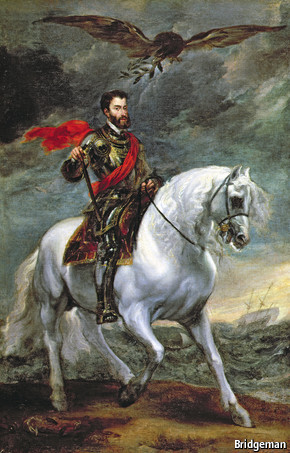 The new Charlemagne
The new Charlemagne
Christendom Destroyed: Europe 1517-1648. By Mark Greengrass. Allen Lane; 722 pages; £30. Buy from Amazon.com, Amazon.co.uk
THE new Penguin History of Europe, edited by Sir David Cannadine, was launched more than a decade ago. With five volumes now out, it is shaping up to be the best general account available, superseding all previous ones. The latest volume covers what might be called the birth of modern Europe, from the Reformation, which broke the dominance of the Roman Catholic church, to the Treaty of Westphalia, which entrenched the idea of the nation-state. It also maps the transition from the medieval notion of Christendom to the modern concept of Europe, something that provides the main theme for Mark Greengrass, now an emeritus professor at Sheffield University.
Purpose and worth
Like the four earlier volumes in the series, this one strays far from the traditional focus on kings and wars. It is rich in the detail of ordinary life, from changes in diet (notably the arrival of new foods from America) and dress to travel and language. Nothing, it seems, is too small to escape this omnivorous author’s attention. The influence of printing emerges as a crucial agent of change. But perhaps most significant is the role of religion and religious war, which is why Martin Luther plays such an important part in the story.
Mr Greengrass’s Christendom was, of course, under attack long before 1517, not least by the Ottoman Turks after their conquest of Constantinople in 1453. And Luther was by no means the first person to criticise the papacy. But the Reformation that he triggered profoundly changed not just all of Europe but, coming just as the continent’s overseas empires were being created, the world. It also contributed to a resurgence of national feeling, epitomised by the passing of Latin as Europe’s common language.
The two countries that came later to dominate Europe, France and Britain, play a surprisingly small role in Mr Greengrass’s period. The main actors were the papacy and the Holy Roman Empire, which under Charles V (pictured) included Spain. The centrality of the empire is made clearer by the fact that both Francis I of France and Henry VIII of England were rivals of the Habsburgs for the title that went to Charles V in 1520. But although he then bestrode the continent like no other ruler since Charlemagne, his empire was soon overstretched and fatally weakened, undermined by Spain’s propensity to default on its debt, by wars with France and England and, after Charles’s death, by the Dutch revolt.
Mr Greengrass pays exhaustive attention to every detail in the post-Luther battles over religious doctrine, which he rightly sees as the underlying cause of most of its wars, culminating in both the Thirty Years War and the English civil war. Indeed, some parts of “Christendom Destroyed” are quite dense for those not already familiar with the history. But the analysis is mostly persuasive, and the decision (common to other volumes in the series) to put most of the politics and warfare at the end of the book, not the start, has much to commend it.
The result is a magisterial and authoritative work that merits just two complaints. The first is that the author is not an elegant stylist. The story is usually gripping, but the prose does not always live up to it. The second is the title. The implication, which also flows through much of the text, is that the overthrow of Christendom was something to regret, not celebrate. Mr Greengrass is right that the wars of religion, especially the horrendous Thirty Years War, were costly in lives and treasure. Yet the escape of much of Europe from the dead hand of a corrupt and backward-looking Catholic church was surely an essential precursor of the continent’s success over the next 300 years. The Reformation may have led to much blood being spilt, but it also made modern Europe. If the Penguin History’s coverage of the early period is anything to go by, that story will doubtless be well told in the volumes still to be published on the 19th and 20th centuries.

